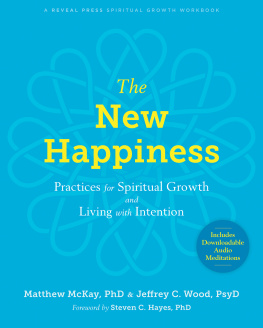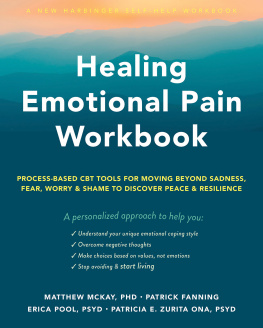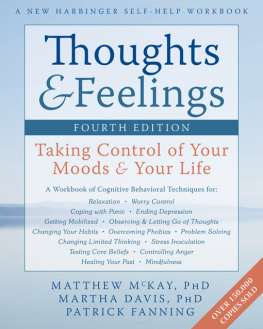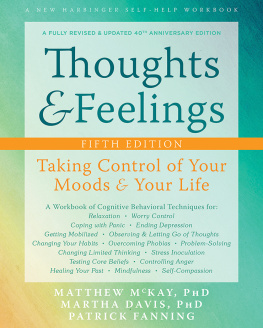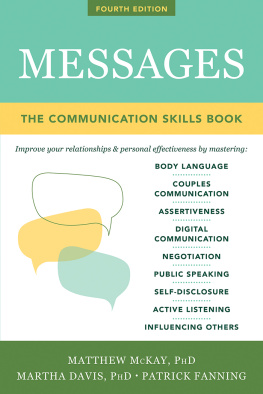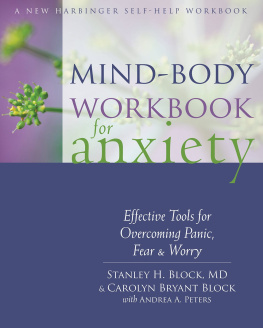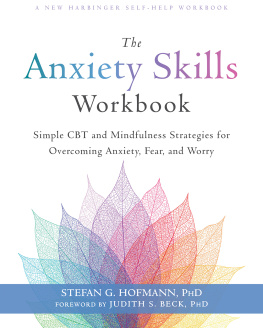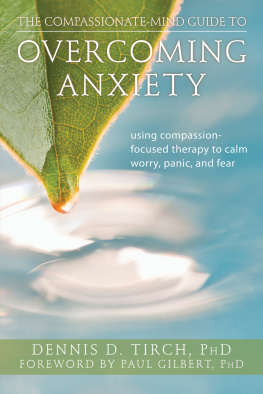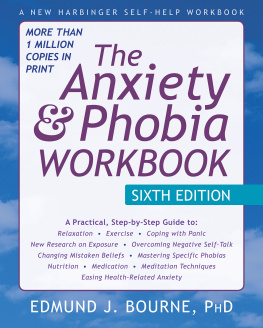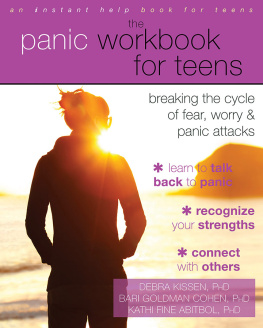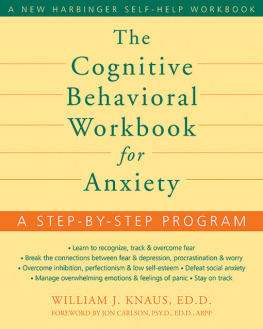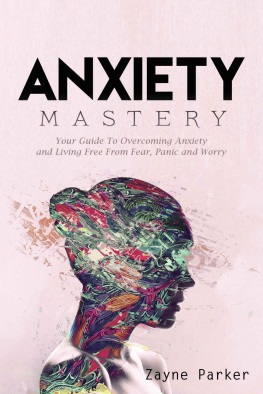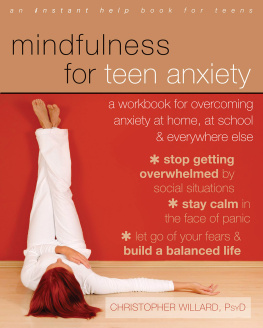Matthew McKay - The CBT Anxiety Solution Workbook: A Breakthrough Treatment for Overcoming Fear, Worry, and Panic
Here you can read online Matthew McKay - The CBT Anxiety Solution Workbook: A Breakthrough Treatment for Overcoming Fear, Worry, and Panic full text of the book (entire story) in english for free. Download pdf and epub, get meaning, cover and reviews about this ebook. year: 2017, publisher: New Harbinger Publications, genre: Romance novel. Description of the work, (preface) as well as reviews are available. Best literature library LitArk.com created for fans of good reading and offers a wide selection of genres:
Romance novel
Science fiction
Adventure
Detective
Science
History
Home and family
Prose
Art
Politics
Computer
Non-fiction
Religion
Business
Children
Humor
Choose a favorite category and find really read worthwhile books. Enjoy immersion in the world of imagination, feel the emotions of the characters or learn something new for yourself, make an fascinating discovery.
- Book:The CBT Anxiety Solution Workbook: A Breakthrough Treatment for Overcoming Fear, Worry, and Panic
- Author:
- Publisher:New Harbinger Publications
- Genre:
- Year:2017
- Rating:3 / 5
- Favourites:Add to favourites
- Your mark:
- 60
- 1
- 2
- 3
- 4
- 5
The CBT Anxiety Solution Workbook: A Breakthrough Treatment for Overcoming Fear, Worry, and Panic: summary, description and annotation
We offer to read an annotation, description, summary or preface (depends on what the author of the book "The CBT Anxiety Solution Workbook: A Breakthrough Treatment for Overcoming Fear, Worry, and Panic" wrote himself). If you haven't found the necessary information about the book — write in the comments, we will try to find it.
The CBT Anxiety Solution Workbook: A Breakthrough Treatment for Overcoming Fear, Worry, and Panic — read online for free the complete book (whole text) full work
Below is the text of the book, divided by pages. System saving the place of the last page read, allows you to conveniently read the book "The CBT Anxiety Solution Workbook: A Breakthrough Treatment for Overcoming Fear, Worry, and Panic" online for free, without having to search again every time where you left off. Put a bookmark, and you can go to the page where you finished reading at any time.
Font size:
Interval:
Bookmark:

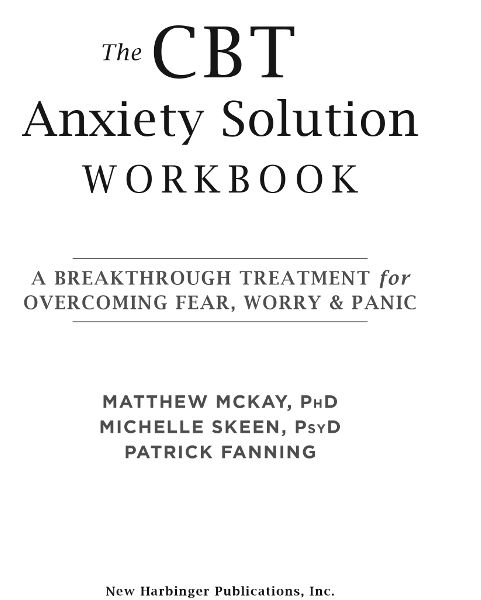
Anxiety, panic, and worries can have crippling and debilitating effects on a persons life. Fortunately, there are effective ways to deal with them. In this beautifully written workbook, McKay, Skeen, and Fanning offer concrete and effective instructions to overcome these problems. I highly recommend this book.
Stefan G. Hofmann, PhD, professor of psychology at Boston University
Combining the best approaches from all three generations of cognitive behavioral therapy (CBT) research and practice, this book is a reliable, evidence-based guide to expand your life when it is restricted by fear. Systematic, clear, and step-by-step, think of it as a roadmap for human liberationyour own, or one you love. Highly recommended.
Steven C. Hayes, PhD, professor of psychology at the University of Nevada, Reno,and author of GetOutofYourMindandIntoYourLife
This workbook beautifully integrates strategies from acceptance and commitment therapy (ACT), cognitive behavioral therapy (CBT), and dialectical behavior therapy (DBT) into practical solutions for a broad spectrum of anxiety problems. McKay, Skeen, and Fanning take readers through a step-by-step process explaining mechanisms underlying anxiety, helping individuals assess problematic coping patterns, and introducing values work to motivate them for the challenge of tackling anxiety in a meaningful and lasting way. Numerous real-life examples validate personal experiences and illustrate how to implement interventions to reduce suffering, which will resonate with clients and clinicians alike.
Rochelle I. Frank, PhD, assistant clinical professor of psychology at the University of California, Berkeley, and coauthor of TheTransdiagnosticRoadMaptoCaseFormulationandTreatmentPlanning
This workbook demystifies anxiety and teaches the nuts and bolts about using strategies from the most up-to-date anxiety protocols and treatments to face your specific fears and cope with fearful thoughts. Its informative, thorough, and easy to follow, with numerous examples to use as guidelines. Whether you suffer from anxiety or you help those who do, this resource offers the practical guidance you need.
Joan Davidson, PhD, codirector and founding partner of the San Francisco Bay Area Center for Cognitive Therapy, and assistant professor in the clinical sciences program at the University of California, Berkeley
This book is based on a number of proven approaches for treating and managing anxiety, including exposure to feared stimuli, mindfulness and acceptance, and cognitive reappraisal. Filled with helpful worksheets and illustrations, the books clear, practical, and accessible format is an excellent option for anyone struggling with anxiety.
Martin M. Antony, PhD, professor of psychology at Ryerson University, and coauthor of TheShynessandSocialAnxietyWorkbook and TheAnti-Anxiety Workbook
Publishers Note
This publication is designed to provide accurate and authoritative information in regard to the subject matter covered. It is sold with the understanding that the publisher is not engaged in rendering psychological, financial, legal, or other professional services. If expert assistance or counseling is needed, the services of a competent professional should be sought.
Distributed in Canada by Raincoast Books
Copyright 2017 by Matthew McKay, Michelle Skeen, and Patrick Fanning
New Harbinger Publications, Inc.
5674 Shattuck Avenue
Oakland, CA 94609
www.newharbinger.com
Cover design by Amy Shoup
Acquired by Catharine Meyers
Edited by Susan LaCroix
All Rights Reserved
Library of Congress Cataloging-in-Publication Data on file
Fear is a natural and valuable emotion. It has great survival value for human beings, preparing us to fight for survival or run away quickly from a threat. But too much fear in the form of chronic anxiety is incredibly painful and debilitating.
Anxiety is prolonged fear that persists in the absence of a real threat: after a threat is over, during situations that arent actually very dangerous, or before a potential threat in the future. When anxiety becomes chronic and dominates your life, it morphs into an anxiety disorder.
Research consistently shows that cognitive behavioral therapy (CBT) is the most effective anxiety treatment. It works better than drugs, psychoanalysis, hypnosis, and all the other ways we have tried to treat anxiety over the years.
Broadly speaking, two CBT approaches for treating anxiety have emerged: coping and exposure. Coping is changing how you think, evaluating threats more accurately, and building confidence in your ability to handle a threat so that you are gradually less afraid. Exposure is purposefully experiencing what you are afraid of, disproving your dire predictions of disaster, until your fear naturally subsides. The most recent data show that both approaches help, but exposure can work faster and results in larger, longer-lasting reductions in anxiety.
The first two-thirds of this book teach you everything you need to know to apply the latest and most effective protocol for exposure, called inhibitory learning. It was developed by a team of therapists and researchers (Craske, Treanor, Conway, Zbozinek, and Vervliet) who published their results in 2014. This special exposure process will help you overcome anxiety as rapidly and completely as possible.
This book also covers the most effective coping strategies used in CBT and related therapies: coping planning, defusion, cognitive flexibility, and distress tolerance. They are research-tested, highly effective techniques that will augment and strengthen your anxiety recovery program.
Using this book is simple: continue reading, working through the first six chapters in order. Do the exercises as you come to them, thoroughly and diligently, before going on to the next section or skipping ahead. Along the way, you may be advised to also work in chapters 710. Finally, read the final chapter on relapse prevention.
You are about to start a challenging but very rewarding journey. Here is a preview of the main attractions:
Chapter 2 goes into the details of the alarm response, how we perceive and appraise threats, the fight/flight reaction, and typical behavioral responses. It allows you to compare your symptoms to the six most commonly diagnosed anxiety disorders:
- Generalized anxiety disorder
- Social anxiety disorder
- Obsessive-compulsive disorder
- Panic disorder
- Specific phobia
- Post-traumatic stress disorder
You will begin making a list of feared situations that you will carry forward into future chapters. At the end of the chapter is an exercise to help you identify your particular fear response and begin to shape your treatment plan.
Chapter 3 is all about assessment. You will begin an inventory of your feared situations, your level of distress for each, and which of several safety behaviors you tend to use:
- Avoiding whats making you anxious
- Seeking reassurance from others
- Distraction
- Procrastination
Font size:
Interval:
Bookmark:
Similar books «The CBT Anxiety Solution Workbook: A Breakthrough Treatment for Overcoming Fear, Worry, and Panic»
Look at similar books to The CBT Anxiety Solution Workbook: A Breakthrough Treatment for Overcoming Fear, Worry, and Panic. We have selected literature similar in name and meaning in the hope of providing readers with more options to find new, interesting, not yet read works.
Discussion, reviews of the book The CBT Anxiety Solution Workbook: A Breakthrough Treatment for Overcoming Fear, Worry, and Panic and just readers' own opinions. Leave your comments, write what you think about the work, its meaning or the main characters. Specify what exactly you liked and what you didn't like, and why you think so.


